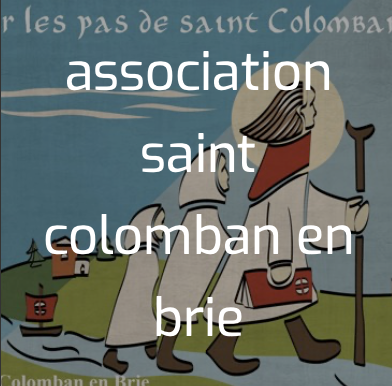Ussy-sur-Marne to Nanteuil-sur-Marne

Île-de-France
15. Ussy-sur-Marne to Nanteuil-sur-Marne
Medium
6h
21,8km
+462m
-451m
Step
Embed this item to access it offline
A first stop in Jouarre to discover the crypts dating from the Merovingian period and a visit to the Notre-Dame Abbey which houses a community of Benedictine nuns. The intangible heritage of the grinding industry in La Ferté-sous-Jouarre.
Along the towpaths along the river, the forest roads, the small villages and then the vineyard paths, this varied itinerary will provide you with some beautiful encounters.
Along the towpaths along the river, the forest roads, the small villages and then the vineyard paths, this varied itinerary will provide you with some beautiful encounters.
11 points of interest
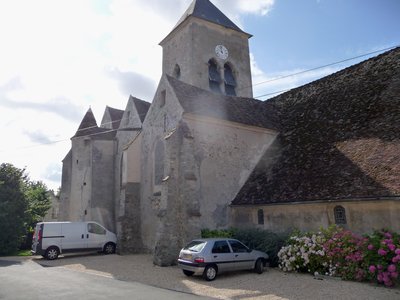
Vue du bas-côté nord de l’église Saint-Authaire - Association Colomban en Brie St ColumbanÉChurch Saint-Authaire à Ussy-sur-Marne
In the life of Saint Colomban, written around 640, the monk Jonas de Bobbio indicates that Colomban and his companions were welcomed by the family of Authaire, an aristocrat at the court of Austrasia. The domus where this servant of Théodebert (or Thibert) king of Austrasia and friend of Colomban, resided, would be located in the commune of Ussy-sur-Marne.
If archaeological excavations do not allow us to date the church of Ussy-sur-Marne with certainty, it is very likely that Authaire, a fervent Christian, was buried in a consecrated place near his residence.
The hagiograph of Saint Colomban tells us that he blessed two children of Authaire, Dadon who became bishop of Rouen under the name of Saint-Ouen and Adon founder of the monastery of Jouarre.
In the church, a 19th century stained glass window reminds us of this meeting. This stained glass window was restored in 2013 by the St Authaire Parish Association with the help of the Town Hall.
The foundations of the church allow us to date it from the 9th century, during the following centuries several extensions were made. It is composed of a nave with a north aisle that extends to a chapel dedicated to the Virgin Mary. The nave and the north aisle are separated by a row of large pointed arches supported by quadrangular piers. The nave is carpentry. The choir is vaulted.
The church is listed as a Historic Monument for its 11th and 12th century nave, and the glass canopies of its 16th century Chapel of the Virgin.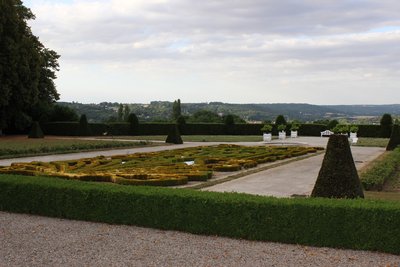
Le parc du Château de Venteil - Blog Chantal Schuller HistoricalCastle Venteuil in Jouarre
Before arriving in Jouarre you will go around the park of the Château de Venteuil. In 1760, the Baron d'Obenheim, a German lieutenant-general, had the castle built by the architect Saget des Louvières. It was acquired 150 years later by Antoine-Laurent de Jussieu. This elegant 18th century residence with sober lines was the residence of the Jussieu family, a family that included five famous botanists. Today the property is private and cannot be visited.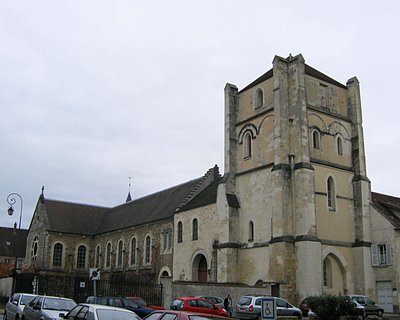
La Tour romane et l’église abbatiale des moniales de Jouarre - Association Colomban en Brie St ColumbanNotre-Dame de Jouarre Abbey
In the 7th century the lands of Jouarre belonged to the family of Authaire, an Austrasian nobleman who had welcomed the Colomban monks and his companions in 610. Colomban blessed two of his sons Dadon, future bishop of Rouen under the name of Saint Ouen and Adon who founded the monastery of Jouarre around 630. He called upon the abbot of the monastery of Luxeuil, founded by Saint Colomban in 590, to receive monks who would organise the community according to the rule of the good fathers Benedict and Colomban as practised at Luxeuil. Initially it was a double monastery welcoming monks and nuns in two separate buildings. In the 9th century, the abbey was an important centre of pilgrimage in the influence of Aachen, capital of the Empire. This new destination for pilgrims was to open up points of reception and trade, and the town of Jouarre was born.
A community of Benedictine nuns animates it nowadays. The whole of Notre-Dame Abbey is classified as a historical monument on the 1840 list.
The Romanesque Tower of the Abbey is undoubtedly the monument that best sums up the history of Jouarre. Built at the end of the 11th century on Gallo-Roman foundations, it is attached to the facade of the abbey church. Its high silhouette and its bells have made it a faithful landmark for travellers from the outset: "Toujours je veille" is still the motto of the town today.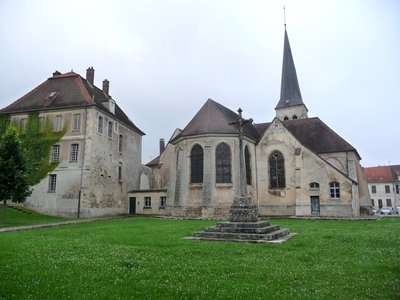
L’église Saint-Pierre et Saint-Paul de Jouarre, vue depuis le chevet - Association Colomban en Brie TouristChurch Saint-Pierre et Saint-Paul à Jouarre
The church, begun in 1440 with the tower and choir and completed in 1559, retains three 16th century glass canopies, damaged during the Second World War.
A beautiful calvary and reliquary hunts remind visitors that Jouarre was a place of pilgrimage in the Middle Ages.
Vue générale de la crypte Saint-Paul - Association Colomban en Brie St ColumbanCrypte Saint-Paul à Jouarre
The crypts of Saint Paul and Saint Ebregisile, located behind the chevet of the parish church of Jouarre, contain the tombs and some cenotaphs of the founders and the first abbots and abbesses of the abbey Notre Dame de Jouarre still preserved in the 21st century. These crypts, whose initial construction dates back to the 7th century, have undergone many changes and alterations that make their history difficult to read. In their architecture as in the decoration of the tombs they contain, they combine the influences of several periods (Merovingian, Carolingian).
The first archaeological excavations of the crypts date back to the early 1840s. The relocation of the cemetery in the immediate vicinity of the crypts enabled Abbot Thiercelin to carry out a comprehensive study of the crypts and the remains of the church of Saint-Paul in 1869-1870.
A monument open during the day, the crypt can be visited with an application and guided tours are organised by the Jouarre tourist office.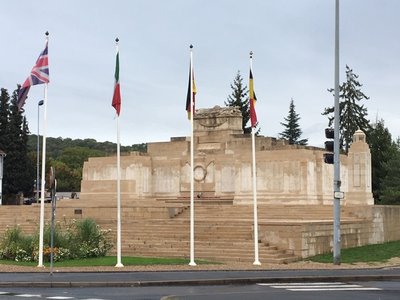
Mémorial britannique de la première guerre mondiale, à La Ferté-sous-Jouarre - Association Colomban en Brie HistoricalBritish First World War Memorial at La Ferté-sous-Jouarre
Just next to the Pont de l'Europe you pass the memorial where the names of 3888 British soldiers who fell in the First Battle of the Marne in September 1914 are engraved. It is the work of the sculptor Goldchmidt in 1928. Fighting was intense at this place so that the British troops, under the command of General French, succeeded in crossing the river on a boat bridge and resuming the offensive. It is surmounted by a sculpture in the shape of a sarcophagus decorated with war trophies, flag, bayonets and helmet. The short sides of the memorial are adorned with a carved sword, pointing downwards, while the front and back of the monument are carved with panels surmounted by a carved crown. The inscriptions are in English and French.
More information Wikipedia
Meules utilisées comme soubassement du quai - Association Colomban en Brie HistoricalL’industrie meulière à la Ferté-sous-Jouarre
The millstone industry in La Ferté-sous-JouarreFor several centuries the quality of the stone from La Ferté-sous-Jouarre has been recognised for its qualities in the manufacture of millstones for cereal mills. Its hardness and its slightly granular aspect allows it to keep its original qualities for a long time.
The reputation of La Ferté millstones has conquered the whole of Europe and the United States.
Until the first half of the 19th century the millstones were shipped by sea, the remains of the millstone port can be seen on the banks of the Marne at La Ferté-sous-Jouarre. At that time there are 4000 workers employed in this extraction and its manufacture making the wealth of local businesses. The economic prosperity develops the small town of La Ferté and the residences of masters are born.
At the end of the 19th century, the arrival of the railroad will give a new economic impetus to this industry. In the middle of the 20th century, grinders made with steel rollers replaced the millstones in the mills. While these allowed for greater efficiency, their speed of rotation separated the germ from the grain as well as its husk. It is the germ that contains most of the nutritional elements of the grain. Flours obtained in this way are lower in protein, minerals and vitamins. The activity of the millers died out in the 1950s.
At La Ferté-sous-Jouarre, on the via Columbani, you can observe the used millstones used to reinforce the road along the Marne river after the bridge of Europe.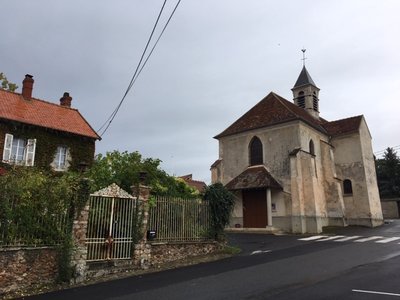
Église Saint-Pierre et Saint-Paul de Rueil-en-Brie - Association Colomban en Brie St ColumbanChurch Saint-Pierre and Saint-Paul de Rueil-en-Brie
Reuil or Radolium keeps the memory of a priory, installed by Radon, a son of Authaire, lord of Ussy visited by Colomban in the 7th century. In the 12th century, it became a Benedictine priory Saint-Pierre-Saint-Paul depending on the abbey of Cluny. Information is lacking to know the history of this priory which would have been built on the site of the church.
The painter Henri Hayden stayed there in the village. In the woods above the village, you will recognize holes, former sites of extraction of millstones, and an area of extraction of clay to make bricks and tiles in Luzancy.
Château de Luzancy - Association Colomban en Brie TouristLuzancy Castle
Built in the Middle Ages and then probably destroyed during the Hundred Years' War; the present building was built in the 15th or 16th century. Owned by Marshal de Berchery, of Hungarian origin and commander of the hussars under Louis XIV, it welcomed illustrious guests such as Chausson and Debussy. Louis XV was the Marshal's guest.
The "freyssinet" bridge is a reconstruction after the destruction of June 1940. Luzancy was often the scene of violent confrontations during the wars of the last centuries. The castle was the seat of the "American Women's Hospital No. 1" of 150 beds managed exclusively by American women doctors, serving the population, after the arrival of the American contingent in 1918. The church is dedicated to St Germain St Leu.
Jean-Baptiste Corot, a painter and engraver in the 17th and 18th centuries, was not the only artist to stay here. The "lodge", a cenacle of artists made it easier for them to stay for a long time at the end of the 19th century. Every year, Corot, a painter from Ville d'Avray and Barbizon, came to stay with his friends Rémy, whose house dominated the rue de l'Eglise and the former rue du Bac, which became allée Corot.
Today the castle of Luzancy is used as a children's home. It welcomes 76 children, teenagers and young adults who encounter difficulties in their family environment.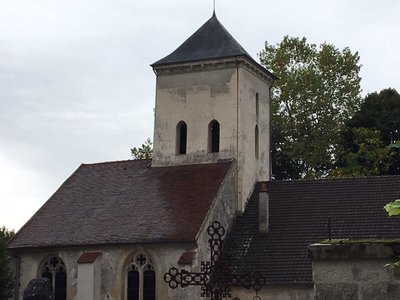
L’église Saint-Germain et Saint-Leu à Luzancy. - Association Colomban en Brie TouristChurch Saint-Germain et Saint-Leu à Luzancy.
The nave of the church preserves remains from the 12th and 13th centuries, but the present building was mainly built towards the end of the 15th or beginning of the 16th century, on the site of the original chapel. This building no longer has its original form, as the nave collapsed around 1837. The ceiling that was rebuilt at that time is only a simple ceiling.
The funeral monument of Marshal Bergery, lord of Luzancy, was placed in the church of Luzancy.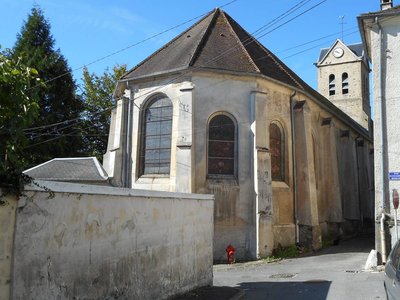
Église Sainte-Marguerite d‘Antioche à Nanteuil-sur-Marne - Fondation du Patrimoine TouristChurch Sainte-Marguerite-d'Antioche à Nanteuil-sur-Marne
The first church in Nanteuil-sur-Marne was destroyed during the Hundred Years War. It was rebuilt in the 16th century and enlarged in the 17th century. The bell tower collapsed in the 19th century and was rebuilt in the 20th century. After the bombings of the Second World War the stained glass windows of the choir were reconstructed from the elements of the old stained glass windows. The ceiling was rebuilt at the same time.
Description
Leave the chevet of the church of Saint-Authaire, rue de la Ferté-sous-Jouarre, turn right on the D21, take the bridge over the Marne and go down to your left carefully to the riverside.
- Go along the left bank of the Marne, first road on the right to leave the Marne and cross the D603, rue du four. First road on the left, rue de Tarcq, straight ahead, Sentier du Berger, take the path between the fields on the left at the crossroads.
- Turn right at the crossroads with tarmac road, cross the D21, go over the Ru de Péreuse, turn right at the next crossroads, at the next crossroads turn left, right in the subdivision of Sept Sorts, chemin de Péreuse, left path following the edge of the wood marked red and white on the aqueduct of the Dhuys.
- Entering the forest stay on the red and white markings of the aqueduct, cross the street of the Croix Saint-Pierre, continue in the forest, on the right at the crossroads with asphalt road, go along the back of the park of the Château de Ventueil, on the right then immediately on the left at the crossroads, chemin de Venteuil, in Jouarre on the right, rue de la Ferté-sous-Jouarre, second street on the left, ruelle du Pressoir.
- In front of the church of Jouarre on the left, rue du Petit Palais, on the left rue de la Fontaine, on the right in the dirt road between two houses, cross the forest, straight ahead at the crossroads, on the left crossroads asphalt road in front of the mill of Petit Morin
- On the left, rue du Petit Condetz, on the right rue du Déversoir, on the right avenue F.Roosselvelt, and cross the Petit Morin, at the roundabout take a dirt road on the left and follow the right bank of the Petit Morin, on the right at the confluence of the Petit Morin and the Marne follow the left bank of the Marne, pass under the Pont de l'Europe bridge, follow quai des Anglais, cross rue du Faubourg in front of the Charles-de-Gaulle bridge, stay on the left bank of the Marne, quai André Planson then rue du Stade follow the towpath on the banks of the Marne.
- Right after 1000 meters at the end of the sports fields, left crossroads with D 402, right rue de Rohan, at the crossroads right, rue du Prieuré, left rue du Commandant Frot, second right rue du Tillet, take the tarred road that runs along the cemetery go up opposite on the hill in the wood. Take the first road on the left, at the houses, at the crossroads turn left, join the D70a, turn right, at the crossroads turn left.
- At Vauharlin, turn right, take the narrow path at the foot of a calvary, go straight down towards Luzancy, straight ahead at the crossroads of the Allée Corot, turn right into Rue de l'Eglise, then Rue de la Croix du Bac, in front of the Marne on the left, cross the Marne on the D402,
- After the bridge at the crossroads, in front of you, second on the left, go up rue du Bac, towards Mery, left Grande Rue, first road on the right, go into the forest, Chemin rural du Dessus du Temple, on the edge of the forest, right at the intersection rue de la Charrière, right rue de Passy, left rue Alexandre Morlot you arrive at the church of Nanteuil-sur-Marne.
- Departure : Church Saint-Authaire, rue de Changis, 77260 Ussy-sur-Marne
- Arrival : Church Sainte-Marguerite d’Antioche, rue de l’église, 77730 Nanteuil-sur-Marne
- Towns crossed : Île-de-France
Altimetric profile
Report a problem or an error
If you have found an error on this page or if you have noticed any problems during your hike, please report them to us here:


